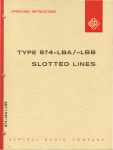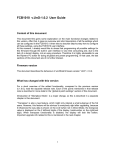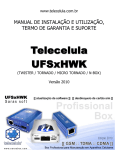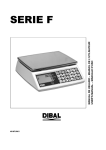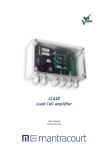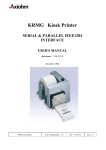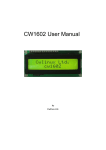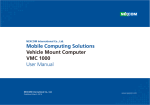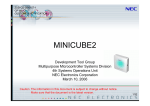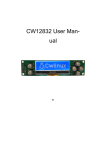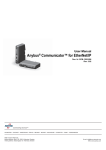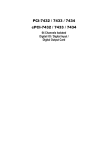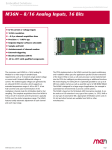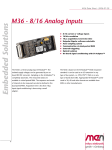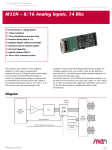Download NuDAQ® PCI-7442/7443/7444
Transcript
NuDAQ® PCI-7442/7443/7444 128-CH/64-CH Isolated Digital I/O Cards User’s Manual Manual Rev. 2.01 Revision Date: March 12, 2007 Part No: 50-11218-2000 Advance Technologies; Automate the World. Copyright 2007 ADLINK TECHNOLOGY INC. All Rights Reserved. The information in this document is subject to change without prior notice in order to improve reliability, design, and function and does not represent a commitment on the part of the manufacturer. In no event will the manufacturer be liable for direct, indirect, special, incidental, or consequential damages arising out of the use or inability to use the product or documentation, even if advised of the possibility of such damages. This document contains proprietary information protected by copyright. All rights are reserved. No part of this manual may be reproduced by any mechanical, electronic, or other means in any form without prior written permission of the manufacturer. Trademarks NuDAQ, NuIPC, DAQBench are registered trademarks of ADLINK TECHNOLOGY INC. Product names mentioned herein are used for identification purposes only and may be trademarks and/or registered trademarks of their respective companies. Getting service Customer satisfaction is our top priority. Contact us should you require any service or assistance. ADLINK TECHNOLOGY INC. Web Site Sales & Service Telephone No. Fax No. Mailing Address http://www.adlinktech.com [email protected] +886-2-8226-5877 +886-2-8226-5717 9F No. 166 Jian Yi Road, Chungho City, Taipei Hsien 235, Taiwan, ROC ADLINK TECHNOLOGY AMERICA, INC. Sales & Service Toll-Free Fax No. Mailing Address [email protected] +1-866-4-ADLINK (235465) +1-949-727-2099 8900 Research Drive, Irvine, CA 92618, USA ADLINK TECHNOLOGY EUROPEAN SALES OFFICE Sales & Service Toll-Free Fax No. Mailing Address [email protected] +49-211-4955552 +49-211-4955557 Nord Carree 3, 40477 Düsseldorf, Germany ADLINK TECHNOLOGY SINGAPORE PTE LTD Sales & Service Telephone No. Fax No. Mailing Address [email protected] +65-6844-2261 +65-6844-2263 84 Genting Lane #07-02A, Cityneon Design Center, Singapore 349584 ADLINK TECHNOLOGY INDIA LIAISON OFFICE Sales & Service Telephone No. Fax No. Mailing Address [email protected] +91-80-57605817 +91-80-26671806 No. 1357, Ground Floor, "Anupama", Aurobindo Marg JP Nagar (Ph-1) Bangalore - 560 078 ADLINK TECHNOLOGY BEIJING Sales & Service Telephone No. Fax No. Mailing Address [email protected] +82-2-20570565 +82-2-20570563 4F, Kostech Building, 262-2, Yangjae-Dong, Seocho-Gu, Seoul, 137-130, Korea ADLINK TECHNOLOGY BEIJING Sales & Service Telephone No. Fax No. Mailing Address [email protected] +86-10-5885-8666 +86-10-5885-8625 Room 801, Building E, Yingchuangdongli Plaza, No.1 Shangdidonglu, Haidian District, Beijing, China ADLINK TECHNOLOGY SHANGHAI Sales & Service Telephone No. Fax No. Mailing Address [email protected] +86-21-6495-5210 +86-21-5450-0414 Floor 4, Bldg. 39, Caoheting Science and Technology Park, No.333 Qinjiang Road, Shanghai , China ADLINK TECHNOLOGY SHENZHEN Sales & Service Telephone No. Fax No. Mailing Address [email protected] +86-755-2643-4858 +86-755-2664-6353 C Block, 2nd Floor, Building A1, Cyber-tech Zone, Gaoxin Ave. 7.S, High-tech Industrial Park S., Nanshan District, Shenzhen, Guangdong Province, China Using this manual 1.1 Audience and scope This manual guides you when using ADLINK NuDAQ® digital input/output PCI cards. The card’s hardware and register information are provided for faster application building. This manual is intended for computer programmers and hardware engineers with advanced knowledge of data acquisition and high-level programming. 1.2 How this manual is organized This manual is organized as follows: Chapter 1 Introduction: This chapter intoduces the NuDAQ® digital input/output PCI cards including the card features, specifications, software support information, and package contents. Chapter 2 Hardware Information: This chapter presents the cards’ layout and pin definitions for internal and external connectors. Chapter 3 Operation Theory: This section illustrates the technology, features, and functions of the cards. Chapter 4 Register Format: This chapter provides detailed descriptions of the register formats that are necessary to operate the cards. Warranty Policy: This presents the ADLINK Warranty Policy terms and coverages. 1.3 Conventions Take note of the following conventions used throughout the manual to make sure that you perform certain tasks and instructions properly. NOTE Additional information, aids, and tips that help you perform particular tasks. IMPORTANT Critical information and instructions that you MUST perform to complete a task. WARNING Information that prevents physical injury, data loss, module damage, program corruption etc. when trying to complete a particular task. Table of Contents List of Tables.......................................................................... iii List of Figures ........................................................................ iv 1 Introduction ........................................................................ 1 1.1 1.2 1.3 1.4 1.5 Features............................................................................... 2 Applications ......................................................................... 2 Specifications....................................................................... 3 Unpacking Checklist ............................................................ 5 Software Support ................................................................. 6 Programming library ....................................................... 6 DAQ-LVIEW PnP: LabVIEW® Driver ............................. 6 DAQBenchTM: ActiveX Controls .................................... 7 2 Hardware Information ........................................................ 9 2.1 2.2 2.3 2.4 2.5 2.6 Card Layout ......................................................................... 9 Bracket Layout .............................................................. 12 PCI-7442 Pin Assignments................................................ 13 CN2 Connector ............................................................. 13 CN1 Connector ............................................................. 15 PCI-7443 Pin Assignments................................................ 17 CN2 Connector ............................................................. 17 CN1 Connector ............................................................. 19 PCI-7444 Pin Assignments................................................ 21 CN2 Connector ............................................................. 21 CN1 Connector ............................................................. 23 TTL I/O Connector Pin Assignments ................................. 25 JP3 ............................................................................... 25 JP4 ............................................................................... 25 Board ID (S1)..................................................................... 26 3 Operation theory .............................................................. 27 3.1 3.2 3.3 3.4 Isolated digital input ........................................................... 27 Change of State (COS) interrupt ....................................... 28 Overview ....................................................................... 28 COS detection .............................................................. 28 COS detection architecture ........................................... 29 Isolated digital output channels ......................................... 30 Watchdog timer (WDT) ...................................................... 31 Table of Contents i 3.5 Programmable TTL Input/Output ....................................... 31 4 Register Format ................................................................ 33 4.1 4.2 4.3 4.4 PCI-7442 I/O Registers...................................................... 33 Isolated Digital Input Register ....................................... 33 COS Interrupt Control Registers ................................... 34 Interrupt Status, COS INT Control Read Back Registers .......................................... 36 COS Setup/Latch Registers .......................................... 37 TTL IO Setup, Status, DO and DI Registers ................. 38 Isolated Digital Output and Read Back Registers ......... 40 Power-up DO Setup/Read Register .............................. 42 Watchdog Timer Load, Safety DO Setup/ Read Back Registers .......................................... 43 WDT INT Control, Hot-Reset, and Hold Control Register ......................................... 45 PCI-7443 I/O Registers...................................................... 47 Isolated Digital Input Registers ..................................... 47 COS Interrupt Control Registers ................................... 48 Interrupt Status, COS INT Control Read Back Registers .......................................... 51 COS Setup/Latch Registers .......................................... 53 TTL IO Setup, Status, DO and DI Register ................... 55 PCI-7444 I/O Registers...................................................... 57 Isolated Digital Output/Read Back Registers ................ 57 Power-up DO Setup/Read Back Register ..................... 59 WDT Load Config, Safety DO Setup/ Read Back Registers .......................................... 61 WDT INT Control / Hot-Reset Hold Control Register .... 63 TTL IO Setup, Status, DO and DI Registers ................. 65 Handling PCI Controller Registers ..................................... 67 Warranty Policy ..................................................................... 69 ii Table of Contents List of Tables Table 2-1: TTL/IO (JP3) Connector Pin Assignments ............. 25 Table 2-2: TTL/IO (JP4) Connector Pin Assignments ............. 25 Table 2-3: Board ID Settings ................................................... 26 List of Tables iii List of Figures Figure 2-1: Figure 2-2: Figure 2-3: Figure 2-4: Figure 2-5: Figure 3-1: Figure 3-2: Figure 3-3: Figure 3-4: iv PCI-7442 Layout........................................................ 9 PCI-7443 Layout...................................................... 10 PCI-7444 Layout...................................................... 11 PCI-7440 Series Card Bracket ................................ 12 PCI-7440 Series Connector Pin Reference ............. 12 Photo Coupler.......................................................... 27 COS Timing ............................................................. 28 COS Detection Architecture..................................... 29 Common Ground Connection of Isolated Digital Output ............................................. 30 List of Figures 1 Introduction The ADLINK PCI-7442, PCI-7443, and PCI-7444 cards are highdensity isolated digital I/O cards featuring 128 or 64 channels of digital input, 128 or 64 channels of digital output, and up to 32 TTL channels for a wide range of PCI bus-based industrial applications. X PCI-7442: Isolated 64-CH DI and 64-CH DO card X PCI-7443: Isolated 128-CH DI card X PCI-7444: Isolated 128-CH DO card The card series provide a robust 1,250 VRMS isolation protection which is suitable for most industrial applications. For PCI chassis with multiple PCI-7442/7443/7444 installed, the board ID design feature enables convenient identification of the cards through a switch jumper, allowing quick troubleshooting and maintenance. Introduction 1 1.1 Features Refer to the comparison table below for the card series features. Features PCI-7442 PCI-7443 PCI-7444 Yes Yes Yes Isolated digital input channels 64 128 — Isolated digital output channels 64 — 128 32-bit 3.3 V/ 5 V PCI bus, PnP Change-of-state (COS) detection 64 128 — Channels with 28 V voltage protection 64 128 — Channels with 250 mA sink current 64 — 128 Channels with digital output status read back 64 — 128 DO value retained after hot system reset Yes — Yes Programmable power-up DO status Yes — Yes Programmable safety DO status function when WDT interruption occurs Yes — Yes Watchdog timer Yes — Yes 32 32 32 1250 VRMS isolation Yes Yes Yes Board ID feature Yes Yes Yes TTL I/O channels 1.2 Applications The PCI-7442/7443/7444 is suitable for these applications: 2 X Machine automation X Industrial ON/OFF control X External relay driving X Signal switching X Laboratory automation Introduction 1.3 Specifications Optical isolated digital input (PCI-7442/PCI-7443 only) Input channels 64 (PCI-7442) 128 (PCI-7443) (Note: Use an efficient cooling system and pay particular attention to the card and chassis temperature when using the digital input channels.) Input voltage High: 5 V – 28 V, non-polarity Low: 0 V – 1.5 V, non-polarity Input resistance 4.7 kΩ Isolated voltage 1250 VRMS Interrupt source Change of State (COS) Optical isolated digital output (PCI-7442/PCI-7444 only) Output channels 64 (PCI-7442) 128 (PCI-7444) Output type Open drain power MOSFET driver Output device TPC8206 Output range 5 V – 40 V Sink current 250 mA for all channel @ 60°C, 100% duty (300 mA max.) Isolation voltage 1250 VRMS Data transfer Programmed I/O Isolated +5V power supply (PCI-7442/PCI-7444 only) Output voltage +5 V Output current 100 mA maximum at 40°C Programmable TTL I/O Number of I/O channels 32 Digital logic level TTL / 3.3 V TTL Current rating 4 mA (max) per channel Data transfer Programmed I/O Watchdog timer (PCI-7442/PCI-7444 only) Base clock available 10 MHz (fixed) Counter-width 32-bit Continued on next page. Introduction 3 Safety functions (PCI-7442/PCI-7444 only) • Programmable power-up DO initial status • Programmable safety DO status function even during WDT interruption • Digital output value retention after hot system reset General specifications Dimensions 174.7 mm (L) x 106.7 mm (W), standard PCI Bus 32-bit PCI bus Operating temperature 0°C – 60°C Storage temperature -40°C – 80°C Humidity 5% to 85% non-condensing Power Power consumption PCI-7442: +5 V at 800 mA (typical) PCI-7443: +5 V at 550 mA (typical) PCI-7444: +5 V at 800 mA (typical) Specifications are subject to change without notice. 4 Introduction 1.4 Unpacking Checklist Before unpacking, check the shipping carton for any damage. If the shipping carton and/or contents are damaged, inform your dealer immediately. Retain the shipping carton and packing materials for inspection. Obtain authorization from your dealer before returning any product to ADLINK. Check if the following items are included in the package. X PCI-7442/PCI-7443/PCI-7444 card X ACL-10337 DB37F bracket X ADLINK All-in-One CD X User’s manual If any of the items is damaged or missing, contact your dealer immediately. NOTE The packaging of OEM versions with non-standard configuration, functionality, or package may vary according to different configuration requests. CAUTION The boards must be protected from static discharge and physical shock. Never remove any of the socketed parts except at a static-free workstation. Use the anti-static bag shipped with the product to handle the board. Wear a grounded wrist strap when servicing. Introduction 5 1.5 Software Support ADLINK provides versatile software drivers and packages to address different approaches in building a system. Aside from programming libraries such as DLLs for many Windows® -based systems, ADLINK also provides drivers for other software packages including LabVIEW®. All software options may be found in the ADLINK All-in-One CD. Programming library If you are writing you own programs, the following function libraries are available: DOS Library For Borland C/C++, and Visual C++, the functions descriptions are included in this user’s guide. PCIS-DASK Included device drivers and DLL for Windows® 98/NT/2000/ XP. A DLL is a binary compatible across Windows® 98/NT/ 2000/XP. That means all applications developed with PCISDASK are compatible across Windows® 98/NT/2000/XP. The developing environment can be VB, VC++, Delphi, BC5, or any Windows® programming language that allows calls to a DLL. The user’s guide and function reference manual of PCIS-DASK are in the CD. Refer to the manual files in the All-in-One CD (\\Manual_PDF\Software\PCIS-DASK). These software drivers are shipped with the board. Refer to the Software Installation Guide for installation procedures. DAQ-LVIEW PnP: LabVIEW® Driver DAQ-LVIEW PnP contains VIs that are used to interface with the LabVIEW® software package. DAQ-LVIEW PnP supports Windows® 95/98/NT/2000/XP. The LabVIEW® drivers are shipped free with the board. You can install and use them without a license. For more information about DAQ-LVIEW PnP, refer to the user’s guide in the All-in-One CD. 6 Introduction DAQBenchTM: ActiveX Controls It is recommended for programmers familiar with ActiveX controls and VB/VC++ programming to use the DAQBench™ ActiveX Control component library for developing applications. The DAQBench™ is designed under Windows® NT/98 environment. For more information about DAQBench™, refer to the user’s guide in the All-in-One CD. Introduction 7 8 Introduction 2 Hardware Information This chapter provides information on the PCI-7442/7443/7444 card layout, connectors, and pin assignments. 2.1 Card Layout Figure 2-1 shows the location of the PCI-7442 connectors, switch, and jumpers. 1 3 2 4 5 Figure 2-1: PCI-7442 Layout 1 CN2 64-CH isolated digital output connector 2 CN1 64-CH isolated digital input connector 3 S1 Board ID DIP switch 4 JP3 16-CH (TTL0~15) TTL I/O connector 5 JP4 16-CH (TTL15~31) TTL I/O connector Hardware Information 9 Figure 2-2 shows the location of the PCI-7443 connectors and DIP switch. 1 3 2 4 5 Figure 2-2: PCI-7443 Layout 1 CN2 64-CH isolated digital input connector (IDI 64~127) 2 CN1 64-CH isolated digital input connector (IDI 0~63) 3 S1 Board ID DIP switch 4 JP3 16-CH (TTL0~16) TTL I/O connector 5 JP4 16-CH (TTL16~31) TTL I/O connector 10 Hardware Information Figure 2-3 shows the location of the PCI-7444 connectors and DIP switch. 1 3 2 4 5 Figure 2-3: PCI-7444 Layout 1 CN2 64-CH isolated digital output connector (IDO 64~127) 2 CN1 64-CH isolated digital output connector (IDO 0~63) 3 S1 Board ID DIP switch 4 JP3 16-CH (TTL0~15) TTL I/O connector 5 JP4 16-CH (TTL15~31) TTL I/O connector Hardware Information 11 Bracket Layout CN2B CN2A CN1B CN1A Figure 2-4: PCI-7440 Series Card Bracket Connector Pin Reference Terminal B68 Terminal B34 Terminal B68 Terminal B34 Terminal A1 Terminal A35 Terminal A1 Terminal A35 CN2B Terminal B35 Terminal B1 CN2A CN1B CN1A Terminal A68 Terminal A34 Terminal B35 Terminal B1 Terminal A68 Terminal A34 Figure 2-5: PCI-7440 Series Connector Pin Reference 12 Hardware Information 2.2 PCI-7442 Pin Assignments CN2 Connector CN2B CN2A V5V B68 B34 V5V IDO_0 A1 A35 IDO_8 IGND B67 B33 IGND IDO_1 A2 A36 IDO_9 IGND B66 B32 IGND IDO_2 A3 A37 IDO_10 IGND B65 B31 IGND IDO_3 A4 A38 IDO_11 IGND B64 B30 IGND IDO_4 A5 A39 IDO_12 IGND B63 B29 IGND IDO_5 A6 A40 IDO_13 IGND B62 B28 IGND IDO_6 A7 A41 IDO_14 IGND B61 B27 IGND IDO_7 A8 A42 IDO_15 VDD8 B60 B26 VDD7 VDD1 A9 A43 VDD2 IDO_63 B59 B25 IDO_55 IGND A10 A44 IGND IDO_62 B58 B24 IDO_54 IGND A11 A45 IGND IDO_61 B57 B23 IDO_53 IGND A12 A46 IGND IDO_60 B56 B22 IDO_52 IGND A13 A47 IGND IDO_59 B55 B21 IDO_51 IGND A14 A48 IGND IDO_58 B54 B20 IDO_50 IGND A15 A49 IGND IDO_57 B53 B19 IDO_49 IGND A16 A50 IGND IDO_56 B52 B18 IDO_48 N/C A17 A51 N/C N/C B51 B17 N/C IDO_16 A18 A52 IDO_24 IGND B50 B16 IGND IDO_17 A19 A53 IDO_25 IGND B49 B15 IGND IDO_18 A20 A54 IDO_26 IGND B48 B14 IGND IDO_19 A21 A55 IDO_27 IGND B47 B13 IGND IDO_20 A22 A56 IDO_28 IGND B46 B12 IGND IDO_21 A23 A57 IDO_29 IGND B45 B11 IGND IDO_22 A24 A58 IDO_30 IGND B44 B10 IGND IDO_23 A25 A59 IDO_31 VDD6 B43 B9 VDD5 VDD3 A26 A60 VDD4 IDO_47 B42 B8 IDO_39 IGND A27 A61 IGND IDO_46 B41 B7 IDO_38 IGND A28 A62 IGND IDO_45 B40 B6 IDO_37 IGND A29 A63 IGND IDO_44 B39 B5 IDO_36 IGND A30 A64 IGND IDO_43 B38 B4 IDO_35 IGND A31 A65 IGND IDO_42 B37 B3 IDO_34 IGND A32 A66 IGND IDO_41 B36 B2 IDO_33 IGND A33 A67 IGND IDO_40 B35 B1 IDO_32 N/C A34 A68 N/C Hardware Information 13 Pin Definition Pin 14 Definition IDO_n Isolated digital output channel n VDD1 common VDD junction for input channel 0-7 VDD2 common VDD junction for input channel 8-15 VDD3 common VDD junction for input channel 16-23 VDD4 common VDD junction for input channel 24-31 VDD5 common VDD junction for input channel 32-39 VDD6 common VDD junction for input channel 40-47 VDD7 common VDD junction for input channel 48-55 VDD8 common VDD junction for input channel 56-63 IGND Ground return path for isolated output channels V5V Onboard un-regulated 5V power supply output N/C No Connect Hardware Information CN1 Connector CN1B CN1A N/C B68 B34 N/C IDI_0 A1 A35 IDI_8 COM8 B67 B33 COM7 IDI_1 A2 A36 IDI_9 COM8 B66 B32 COM7 IDI_2 A3 A37 IDI_10 COM8 B65 B31 COM7 IDI_3 A4 A38 IDI_11 COM8 B64 B30 COM7 IDI_4 A5 A39 IDI_12 COM8 B63 B29 COM7 IDI_5 A6 A40 IDI_13 COM8 B62 B28 COM7 IDI_6 A7 A41 IDI_14 COM8 B61 B27 COM7 IDI_7 A8 A42 IDI_15 COM8 B60 B26 COM7 COM1 A9 A43 COM2 IDI_63 B59 B25 IDI_55 COM1 A10 A44 COM2 IDI_62 B58 B24 IDI_54 COM1 A11 A45 COM2 IDI_61 B57 B23 IDI_53 COM1 A12 A46 COM2 IDI_60 B56 B22 IDI_52 COM1 A13 A47 COM2 IDI_59 B55 B21 IDI_51 COM1 A14 A48 COM2 IDI_58 B54 B20 IDI_50 COM1 A15 A49 COM2 IDI_57 B53 B19 IDI_49 COM1 A16 A50 COM2 IDI_56 B52 B18 IDI_48 N/C A17 A51 N/C N/C B51 B17 N/C IDI_16 A18 A52 IDI_24 COM6 B50 B16 COM5 IDI_17 A19 A53 IDI_25 COM6 B49 B15 COM5 IDI_18 A20 A54 IDI_26 COM6 B48 B14 COM5 IDI_19 A21 A55 IDI_27 COM6 B47 B13 COM5 IDI_20 A22 A56 IDI_28 COM6 B46 B12 COM5 IDI_21 A23 A57 IDI_29 COM6 B45 B11 COM5 IDI_22 A24 A58 IDI_30 COM6 B44 B10 COM5 IDI_23 A25 A59 IDI_31 COM6 B43 B9 COM5 COM3 A26 A60 COM4 IDI_47 B42 B8 IDI_39 COM3 A27 A61 COM4 IDI_46 B41 B7 IDI_38 COM3 A28 A62 COM4 IDI_45 B40 B6 IDI_37 COM3 A29 A63 COM4 IDI_44 B39 B5 IDI_36 COM3 A30 A64 COM4 IDI_43 B38 B4 IDI_35 COM3 A31 A65 COM4 IDI_42 B37 B3 IDI_34 COM3 A32 A66 COM4 IDI_41 B36 B2 IDI_33 COM3 A33 A67 COM4 IDI_40 B35 B1 IDI_32 N/C A34 A68 N/C Hardware Information 15 Pin Definition Pin IDI_n Isolated digital input channel n COM1 common junction for input channel 0-7 COM2 common junction for input channel 8-15 COM3 common junction for input channel 16-23 COM4 common junction for input channel 24-31 COM5 common junction for input channel 32-39 COM6 common junction for input channel 40-47 COM7 common junction for input channel 48-55 COM8 common junction for input channel 56-63 N/C 16 Definition No Connect Hardware Information 2.3 PCI-7443 Pin Assignments CN2 Connector CN2B CN2A N/C B68 B34 N/C IDI_64 A1 A35 IDI_72 COM16 B67 B33 COM15 IDI_65 A2 A36 IDI_73 COM16 B66 B32 COM15 IDI_66 A3 A37 IDI_74 COM16 B65 B31 COM15 IDI_67 A4 A38 IDI_75 COM16 B64 B30 COM15 IDI_68 A5 A39 IDI_76 COM16 B63 B29 COM15 IDI_69 A6 A40 IDI_77 COM16 B62 B28 COM15 IDI_70 A7 A41 IDI_78 COM16 B61 B27 COM15 IDI_71 A8 A42 IDI_79 COM16 B60 B26 COM15 COM9 A9 A43 COM10 IDI_127 B59 B25 IDI_119 COM9 A10 A44 COM10 IDI_126 B58 B24 IDI_118 COM9 A11 A45 COM10 IDI_125 B57 B23 IDI_117 COM9 A12 A46 COM10 IDI_124 B56 B22 IDI_116 COM9 A13 A47 COM10 IDI_123 B55 B21 IDI_115 COM9 A14 A48 COM10 IDI_122 B54 B20 IDI_114 COM9 A15 A49 COM10 IDI_121 B53 B19 IDI_113 COM9 A16 A50 COM10 IDI_120 B52 B18 IDI_112 N/C A17 A51 N/C N/C B51 B17 N/C IDI_80 A18 A52 IDI_88 COM14 B50 B16 COM13 IDI_81 A19 A53 IDI_89 COM14 B49 B15 COM13 IDI_82 A20 A54 IDI_90 COM14 B48 B14 COM13 IDI_83 A21 A55 IDI_91 COM14 B47 B13 COM13 IDI_84 A22 A56 IDI_92 COM14 B46 B12 COM13 IDI_85 A23 A57 IDI_93 COM14 B45 B11 COM13 IDI_86 A24 A58 IDI_94 COM14 B44 B10 COM13 IDI_87 A25 A59 IDI_95 COM14 B43 B9 COM13 COM11 A26 A60 COM12 IDI_111 B42 B8 IDI_103 COM11 A27 A61 COM12 IDI_110 B41 B7 IDI_102 COM11 A28 A62 COM12 IDI_109 B40 B6 IDI_101 COM11 A29 A63 COM12 IDI_108 B39 B5 IDI_100 COM11 A30 A64 COM12 IDI_107 B38 B4 IDI_99 COM11 A31 A65 COM12 IDI_106 B37 B3 IDI_98 COM11 A32 A66 COM12 IDI_105 B36 B2 IDI_97 COM11 A33 A67 COM12 IDI_104 B35 B1 IDI_96 N/C A34 A68 N/C Hardware Information 17 Pin Definition Pin IDI_n Isolated digital input channel n COM9 common junction for input channel 64-71 COM10 common junction for input channel 72-79 COM11 common junction for input channel 80-87 COM12 common junction for input channel 88-95 COM13 common junction for input channel 96-103 COM14 common junction for input channel 104-111 COM15 common junction for input channel 112-119 COM16 common junction for input channel 120-127 N/C 18 Definition No Connect Hardware Information CN1 Connector CN1B CN1A N/C B68 B34 N/C IDI_0 A1 A35 IDI_8 COM8 B67 B33 COM7 IDI_1 A2 A36 IDI_9 COM8 B66 B32 COM7 IDI_2 A3 A37 IDI_10 COM8 B65 B31 COM7 IDI_3 A4 A38 IDI_11 COM8 B64 B30 COM7 IDI_4 A5 A39 IDI_12 COM8 B63 B29 COM7 IDI_5 A6 A40 IDI_13 COM8 B62 B28 COM7 IDI_6 A7 A41 IDI_14 COM8 B61 B27 COM7 IDI_7 A8 A42 IDI_15 COM8 B60 B26 COM7 COM1 A9 A43 COM2 IDI_63 B59 B25 IDI_55 COM1 A10 A44 COM2 IDI_62 B58 B24 IDI_54 COM1 A11 A45 COM2 IDI_61 B57 B23 IDI_53 COM1 A12 A46 COM2 IDI_60 B56 B22 IDI_52 COM1 A13 A47 COM2 IDI_59 B55 B21 IDI_51 COM1 A14 A48 COM2 IDI_58 B54 B20 IDI_50 COM1 A15 A49 COM2 IDI_57 B53 B19 IDI_49 COM1 A16 A50 COM2 IDI_56 B52 B18 IDI_48 N/C A17 A51 N/C N/C B51 B17 N/C IDI_16 A18 A52 IDI_24 COM6 B50 B16 COM5 IDI_17 A19 A53 IDI_25 COM6 B49 B15 COM5 IDI_18 A20 A54 IDI_26 COM6 B48 B14 COM5 IDI_19 A21 A55 IDI_27 COM6 B47 B13 COM5 IDI_20 A22 A56 IDI_28 COM6 B46 B12 COM5 IDI_21 A23 A57 IDI_29 COM6 B45 B11 COM5 IDI_22 A24 A58 IDI_30 COM6 B44 B10 COM5 IDI_23 A25 A59 IDI_31 COM6 B43 B9 COM5 COM3 A26 A60 COM4 IDI_47 B42 B8 IDI_39 COM3 A27 A61 COM4 IDI_46 B41 B7 IDI_38 COM3 A28 A62 COM4 IDI_45 B40 B6 IDI_37 COM3 A29 A63 COM4 IDI_44 B39 B5 IDI_36 COM3 A30 A64 COM4 IDI_43 B38 B4 IDI_35 COM3 A31 A65 COM4 IDI_42 B37 B3 IDI_34 COM3 A32 A66 COM4 IDI_41 B36 B2 IDI_33 COM3 A33 A67 COM4 IDI_40 B35 B1 IDI_32 N/C A34 A68 N/C Hardware Information 19 Pin Definition Pin IDI_n Isolated digital input channel n COM1 common junction for input channel 0-7 COM2 common junction for input channel 8-15 COM3 common junction for input channel 16-23 COM4 common junction for input channel 24-31 COM5 common junction for input channel 32-39 COM6 common junction for input channel 40-47 COM7 common junction for input channel 48-55 COM8 common junction for input channel 56-63 N/C 20 Definition No Connect Hardware Information 2.4 PCI-7444 Pin Assignments CN2 Connector CN2B CN2A V5V B68 B34 V5V IDO_64 A1 A35 IDO_72 IGND B67 B33 IGND IDO_65 A2 A36 IDO_73 IGND B66 B32 IGND IDO_66 A3 A37 IDO_74 IGND B65 B31 IGND IDO_67 A4 A38 IDO_75 IGND B64 B30 IGND IDO_68 A5 A39 IDO_76 IGND B63 B29 IGND IDO_69 A6 A40 IDO_77 IGND B62 B28 IGND IDO_70 A7 A41 IDO_78 IGND B61 B27 IGND IDO_71 A8 A42 IDO_79 VDD16 B60 B26 VDD15 VDD9 A9 A43 VDD10 IDO_127 B59 B25 IDO_119 IGND A10 A44 IGND IDO_126 B58 B24 IDO_118 IGND A11 A45 IGND IDO_125 B57 B23 IDO_117 IGND A12 A46 IGND IDO_124 B56 B22 IDO_116 IGND A13 A47 IGND IDO_123 B55 B21 IDO_115 IGND A14 A48 IGND IDO_122 B54 B20 IDO_114 IGND A15 A49 IGND IDO_121 B53 B19 IDO_113 IGND A16 A50 IGND IDO_120 B52 B18 IDO_112 N/C A17 A51 N/C N/C B51 B17 N/C IDO_80 A18 A52 IDO_88 IGND B50 B16 IGND IDO_81 A19 A53 IDO_89 IGND B49 B15 IGND IDO_82 A20 A54 IDO_90 IGND B48 B14 IGND IDO_83 A21 A55 IDO_91 IGND B47 B13 IGND IDO_84 A22 A56 IDO_92 IGND B46 B12 IGND IDO_85 A23 A57 IDO_93 IGND B45 B11 IGND IDO_86 A24 A58 IDO_94 IGND B44 B10 IGND IDO_87 A25 A59 IDO_95 VDD14 B43 B9 VDD13 VDD11 A26 A60 VDD12 IDO_111 B42 B8 IDO_103 IGND A27 A61 IGND IDO_110 B41 B7 IDO_102 IGND A28 A62 IGND IDO_109 B40 B6 IDO_101 IGND A29 A63 IGND IDO_108 B39 B5 IDO_100 IGND A30 A64 IGND IDO_107 B38 B4 IDO_99 IGND A31 A65 IGND IDO_106 B37 B3 IDO_98 IGND A32 A66 IGND IDO_105 B36 B2 IDO_97 IGND A33 A67 IGND IDO_104 B35 B1 IDO_96 N/C A34 A68 N/C Hardware Information 21 Pin Definition Pin IDO_n Isolated digital output channel n VDD9 common VDD junction for input channel 64-71 VDD10 common VDD junction for input channel 72-79 VDD11 common VDD junction for input channel 80-87 VDD12 common VDD junction for input channel 88-95 VDD13 common VDD junction for input channel 96-103 VDD14 common VDD junction for input channel 104-111 VDD15 common VDD junction for input channel 112-119 VDD16 22 Definition common VDD junction for input channel 120-127 IGND Ground return path for isolated output channels V5V Onboard un-regulated 5V power supply output N/C No Connect Hardware Information CN1 Connector CN1B CN1A N/C B68 B34 N/C IDO_0 A1 A35 IDO_8 IGND B67 B33 IGND IDO_1 A2 A36 IDO_9 IGND B66 B32 IGND IDO_2 A3 A37 IDO_10 IGND B65 B31 IGND IDO_3 A4 A38 IDO_11 IGND B64 B30 IGND IDO_4 A5 A39 IDO_12 IGND B63 B29 IGND IDO_5 A6 A40 IDO_13 IGND B62 B28 IGND IDO_6 A7 A41 IDO_14 IGND B61 B27 IGND IDO_7 A8 A42 IDO_15 VDD8 B60 B26 VDD7 VDD1 A9 A43 VDD2 IDO_63 B59 B25 IDO_55 IGND A10 A44 IGND IDO_62 B58 B24 IDO_54 IGND A11 A45 IGND IDO_61 B57 B23 IDO_53 IGND A12 A46 IGND IDO_60 B56 B22 IDO_52 IGND A13 A47 IGND IDO_59 B55 B21 IDO_51 IGND A14 A48 IGND IDO_58 B54 B20 IDO_50 IGND A15 A49 IGND IDO_57 B53 B19 IDO_49 IGND A16 A50 IGND IDO_56 B52 B18 IDO_48 N/C A17 A51 N/C N/C B51 B17 N/C IDO_16 A18 A52 IDO_24 IGND B50 B16 IGND IDO_17 A19 A53 IDO_25 IGND B49 B15 IGND IDO_18 A20 A54 IDO_26 IGND B48 B14 IGND IDO_19 A21 A55 IDO_27 IGND B47 B13 IGND IDO_20 A22 A56 IDO_28 IGND B46 B12 IGND IDO_21 A23 A57 IDO_29 IGND B45 B11 IGND IDO_22 A24 A58 IDO_30 IGND B44 B10 IGND IDO_23 A25 A59 IDO_31 VDD6 B43 B9 VDD5 VDD3 A26 A60 VDD4 IDO_47 B42 B8 IDO_39 IGND A27 A61 IGND IDO_46 B41 B7 IDO_38 IGND A28 A62 IGND IDO_45 B40 B6 IDO_37 IGND A29 A63 IGND IDO_44 B39 B5 IDO_36 IGND A30 A64 IGND IDO_43 B38 B4 IDO_35 IGND A31 A65 IGND IDO_42 B37 B3 IDO_34 IGND A32 A66 IGND IDO_41 B36 B2 IDO_33 IGND A33 A67 IGND IDO_40 B35 B1 IDO_32 N/C A34 A68 N/C Hardware Information 23 Pin Definition Pin IDO_n Isolated digital output channel n VDD1 common VDD junction for input channel 0-7 VDD2 common VDD junction for input channel 8-15 VDD3 common VDD junction for input channel 16-23 VDD4 common VDD junction for input channel 24-31 VDD5 common VDD junction for input channel 32-39 VDD6 common VDD junction for input channel 40-47 VDD7 common VDD junction for input channel 48-55 VDD8 common VDD junction for input channel 56-63 IGND Ground return path for isolated output channels N/C 24 Definition No Connect Hardware Information 2.5 TTL I/O Connector Pin Assignments JP3 Pin Function Pin Function 1 TTLIO_0 2 TTLIO_8 3 TTLIO_1 4 TTLIO_9 5 TTLIO_2 6 TTLIO_10 7 TTLIO_3 8 TTLIO_11 9 SGND 10 SGND 11 TTLIO_4 12 TTLIO_12 13 TTLIO_5 14 TTLIO_13 15 TTLIO_6 16 TTLIO_14 17 TTLIO_7 18 TTLIO_15 19 SGND 20 SGND Table 2-1: TTL/IO (JP3) Connector Pin Assignments JP4 Pin Function Pin Function 1 TTLIO_16 2 TTLIO_24 3 TTLIO_17 4 TTLIO_25 5 TTLIO_18 6 TTLIO_26 7 TTLIO_19 8 TTLIO_27 9 SGND 10 SGND 11 TTLIO_20 12 TTLIO_28 13 TTLIO_21 14 TTLIO_29 15 TTLIO_22 16 TTLIO_30 17 TTLIO_23 18 TTLIO_31 19 SGND 20 SGND Table 2-2: TTL/IO (JP4) Connector Pin Assignments TTLIO_n SGND TTL I/O channel n System ground for PCI-7440 card series Hardware Information 25 2.6 Board ID (S1) The Board ID feature helps you identify the modules when two or more PCI-7440 Series cards are installed in one system. According to a DIP switch configuration located in the S1, you can assign a specific board ID to a designated card and access it correctly through simple software programming. The table below shows all the switch settings. 1 means DIP is at ON position; 0 means that the DIP is OFF. Board ID Note: 1 = ON, 0 = OFF Default setting is 1111 or Board ID = 0 Switch No. 1 2 3 4 0 1 1 1 1 1 0 1 1 1 2 1 0 1 1 3 0 0 1 1 4 1 1 0 1 5 0 1 0 1 6 1 0 0 1 7 0 0 0 1 8 1 1 1 0 9 0 1 1 0 10 1 0 1 0 11 0 0 1 0 12 1 1 0 0 13 0 1 0 0 14 1 0 0 0 15 0 0 0 0 Table 2-3: Board ID Settings 26 Hardware Information 3 Operation theory 3.1 Isolated digital input The PCI-7442/7443 card comes with 64/128 opto-isolated digital input channels. The circuit diagram of the isolated input channel is shown in Figure 3-1. Figure 3-1: Photo Coupler The digital input is routed first through a photo-coupler (PC3H4) so that the connection are not polarly sensitive whether using positive or negative voltage. The normal input voltage range for high state is from 5 V to 28 V. Operation theory 27 3.2 Change of State (COS) interrupt Overview The COS (Change of State) means either the input state (logic level) changes from low to high, or from high to low. The COS detection circuit will detect the edge of level change. In the PCI7442/7443 card, the COS detection circuit is applied to all the input channels. When any channel changes its logic level, the COS detection circuit generates an interrupt request to PCI controller. COS detection Figure 3-2 is an example of an 8-CH COS operation. All of the enabled DI channels’ signal level change will be detected to generate the interrupt request. While the interrupt request generates, the corresponding DI data will also be latched into the COS latch register. In our COS architecture, the DI data are sampled by a 33 MHz clock. It means the pulse width of the digital input have to last longer than 31 ns, or the COS latch register won’t latch the correct input data. The COS latch register will be erased after clearing the interrupt request. Figure 3-2: COS Timing 28 Operation theory COS detection architecture The COS interrupt system is used in PCI-7442/7443. COS interrupt occurs when the any of enabled DI line sense the status changes either from HIGH to LOW or from LOW to HIGH. The COS interrupt system can generate an interrupt request signal and the software can service this request with ISR. Note that PCI-7442 has two banks (bank 0 from DI0 to DI31 and bank 1 from DI32 to 63) while PCI-7443 has four banks (bank 0 from DI0 to DI31 and bank 1 from DI32 to 63; bank 2 from DI64 to DI95 and bank 3 from DI96 to 127). These banks are cascaded together toward the same IRQ line via CPLD. You can use commands to know which bank or which DI line has COS when it happens. Also, you can use commands to disable or enable the COS function of certain DI lines. The COS function for each is disabled by default. Refer to Figure 3-3 for the COS detection architecture. CN1 CN2 Figure 3-3: COS Detection Architecture Operation theory 29 3.3 Isolated digital output channels The common ground connection of isolated digital output is shown in the figure below. When the isolated digital output goes ON, the sink current will be conducted through the power MOSFETs. When the isolated digital output goes OFF, no current is conducted to flow through the power MOSFETS. Take note that when the load is of an inductance nature such as a relay, coil or motor, the VDD pin must be connected to an external power source. The extra connection is utilized for the fly-wheel diode to form a current-release closed loop, so that the MOSFETs are protected from any high reverse voltage which can be generated by the inductance load when the output is switched from ON to OFF. In addition, you can read back the 64-/128-CH IDO statuses to check if the statuses meet your purpose. x: 0~63 x: 0~127 Figure 3-4: Common Ground Connection of Isolated Digital Output The PCI-7442/PCI-7444 provides three special functions for safety measures. First, the PCI-7442/PCI-7444 could automatically configure the 64-/128-CH DO initial statuses when powering up. Second, you can direct the PCI-7442/PCI-7444 to hold the DO statuses and avoid its power-up initial configuration state after a hot system reset. Third, you can direct the PCI-7442/PCI-7444 to automatically configure the 64-/128-CH DO safety statuses when a WDT interruption asserts. 30 Operation theory 3.4 Watchdog timer (WDT) In safety-critical applications, you can enable the watchdog timer (WDT) function to automatically generate an interrupt signal, in case the operating system or the PCI-7442/PCI-7444 card crashes. To access this function, you must first configure the watchdog timer overflow counter by windows API. Generally, the trigger source would come from the onboard 32-bit watchdog timer. The WDT overflow interval can be programmed through API. You must reload the WDT counter value before enabling the WDT. After enabling the watchdog timer, you must periodically reload the timer value by software command. If the timer is not being reloaded within the specified interval, the WDT module generates an overflow interruption signal. When you enable the SafetyOut_Enable bit, the PCI-7442/PCI-7444 would automatically configure the 64-CH/128-CH DO safety statuses. This WDT function is disabled by default. 3.5 Programmable TTL Input/Output The PCI-7442/7443/7444 card provides a 32-CH programmable TTL input/output. These channels are divided between two connectors: JP3 and JP4. You can change the direction of each TTL channel any time. The I/O voltage level suits with 5 V TTL level and 3.3 V TTL level. But the driving strength of each channel is 4 mA. Pay particular attention to the current consumption of the TTL channel. Operation theory 31 32 Operation theory 4 Register Format This chapter provides the detailed descriptions of the register formats intended for programmers who want to operate the card series through low-level programming. This chapter is intended for users that have basic understanding of the PCI interface. The PCI-7442/7443/7444 card registers are all 16-bit wide and can only be accessed using 16-bit I/O instructions. The isolated digital input/output control is by accessing registers mentioned in this chapter. 4.1 PCI-7442 I/O Registers Isolated Digital Input Register There are 64 isolated inputs on a PCI-7442 card. The statuses of the 64 lines can be read from the four isolated input registers. Each bit corresponds to each channel. The bit value 1 means that the input is ON and 0 means that the input is OFF. Address R/W Value Mapping [MSB (bit15)----LSB (bit0)] BASE+0x02h R IDI[15…0] BASE+0x04h R IDI[31...16] BASE+0x42h R IDI[47...32] R IDI[63...48] BASE+0x44h Bit value: 1: The input is ON 0: The input is OFF (Initial value) Register Format 33 COS Interrupt Control Registers There are two different interrupt modes in PCI-7442. Both interrupt modes are disabled by default. You can write the registers listed below to enable the interrupt. In the first mode, users enable the COS (Change of State) interrupt function to monitor the status of enabled input channels and whenever the status change from 0 to 1 or 1 to 0. In the second mode, you can enable the Watchdog Timer (WDT) Counter. The interrupt asserts when the WDT Counter counts to zero. After processing the interrupt request event, you have to clear the interrupt request in order to handle another interrupt request. Take note that it takes time for a system to clear the interrupt. That is, any COS interrupt or WDT interrupt that came before the previous interrupt and has not cleared will be ignored. To clear the interrupt request, write 1 to the corresponding bit (CLRn). The WDT INT control registers are shown below. The COS interrupt is enabled by two registers. Because the 64 digital inputs are divided into two 32-bit onboard buses, every 32 inputs are connected to a CPLD. When you enable COS interrupt EA0 (BASE+0x06h), the first CPLD (CPLD0) generates an interrupt signal while the first 32 inputs IDI[31..0] have state change. When you enable COS interrupt EA1 (BASE+0x46h), the second CPLD (CPLD1) generates an interrupt signal while the second 32 inputs IDI[63..32] have state change. Address: BASE+0x06h Reset Value: 0x0000h Read/Write: W -- -- -- -- -- -- -- CLR0 Bit7 Bit6 Bit5 Bit4 Bit3 Bit2 Bit1 Bit0 -- -- -- -- -- -- -- EA0 Bit15 Bit14 Bit13 Bit12 Bit11 Bit10 Bit9 Bit8 Bit15 - 9 Not used Bit7 - 1 Not used Bit0 CLR0: COS 0 interrupt clear 1: Clear; 0: No effect Bit8 EA0: COS 0 interrupt enable/disable 1: Enabled; 0: Disabled 34 Register Format Address: BASE+0x46h Reset Value: 0x0000h Read/Write: W -- -- -- -- -- -- -- Bit7 Bit6 Bit5 Bit4 Bit3 Bit2 Bit1 Bit0 -- -- -- -- -- -- -- EA1 Bit15 Bit14 Bit13 Bit12 Bit11 Bit10 Bit9 Bit8 Bit15 - 9 Not used Bit7 - 1 Not used Bit0 CLR1: COS 1 interrupt clear Bit8 EA1: COS 1 interrupt enable/disable CLR1 1: Clear; 0: No effect 1: Enabled; 0: Disabled Register Format 35 Interrupt Status, COS INT Control Read Back Registers When any COS interrupts occur, these registers provide information for you to recognize the interrupt status and the interrupt setup condition read back. Address: BASE+0x06h Reset Value: 0x0000h Read/Write: R -- -- -- -- -- -- CIS1 CIS0 Bit7 Bit6 Bit5 Bit4 Bit3 Bit2 Bit1 Bit0 COS0E -- -- -- -- -- -- -- Bit15 Bit14 Bit13 Bit12 Bit11 Bit10 Bit9 Bit8 Bit14 - 12 Not used Bit0 CIS0: COS 0 interrupt status 1: COS interrupt assert 0: COS interrupt no assert Bit1 CIS1: COS 1 interrupt status 1: COS interrupt assert 0: COS interrupt no assert Bit15 COS0E: COS 0 interrupt enable status 1: COS 0 interrupt enabled 0: COS 0 interrupt disabled Address: BASE+0x46h Reset Value: 0x0000h Read/Write: R -- -- -- -- -- -- -- -- Bit7 Bit6 Bit5 Bit4 Bit3 Bit2 Bit1 Bit0 COS1E -- -- -- -- -- -- -- Bit15 Bit14 Bit13 Bit12 Bit11 Bit10 Bit9 Bit8 Bit14 - 0 Not used Bit15 COS1E: COS 1 interrupt enable status 1: COS 1 interrupt enabled 0: COS 1 interrupt disabled 36 Register Format COS Setup/Latch Registers The PCI-7442 provides a Change of State (COS) interrupt function on any one of digital input channel. This function allows you to monitor the status of digital input channels by setting these registers. By enabling the COS Setup registers, it will generate an interrupt when the corresponding channel changes its state. Address R/W Value Mapping (MSB----LSB) BASE+0x08h W IDI_COS_EN[15…0] BASE+0x0Ah W IDI_COS_EN[31...16] BASE+0x48h W IDI_COS_EN[47...32] W IDI_COS_EN[63...48] BASE+0x4Ah IDI_COS_EN [n]: Bit value: Change-of-State function enable of IDI channel n, n = 0 – 63 0: Disable COS function 1: Enable COS function When COS occurs, the COS latch registers also latch the IDI[31..0], IDI[63..32] data, respectively. Once you clear the interrupt request, the COS latch register automatically clears. Since you can simply read these registers to know the statuses after interrupts, these registers free the CPU from the overwhelming task of constantly polling all inputs, enabling it to handle other tasks. Address R/W Value Mapping (MSB----LSB) BASE+0x08h R IDI_COS_LATCH_DATA[15…0] BASE+0x0Ah R IDI_COS_LATCH_DATA[31...16] BASE+0x48h R IDI_COS_LATCH_DATA[47...32] BASE+0x4Ah R IDI_COS_LATCH_DATA[63...48] Bit value: 1: The input is on. 0: The input is off (initial value). Register Format 37 TTL IO Setup, Status, DO and DI Registers The PCI-7442 provides an extra 32-channel TTL I/O function for optional applications. These TTL I/O channels are divided among two 16-bits banks and are divided between two connectors: JP3 and JP4. You may choose the direction of each TTL channel any time by setting up the two-bank TTL IO setup register. Address R/W Value Mapping (MSB----LSB) BASE+0x0Ch W TTL_IO_SETUP[15…0] W TTL_IO_SETUP[31..16] BASE+0x4Ch Bit value: 0: I/O direction is input (default). 1: I/O direction is output. When you set up the direction of TTL I/O channels, the statuses of setting can be read back through TTL IO Status Read Back Register in each back. You can read back the I/O direction statuses to check if the settings are correct. Address R/W Value Mapping (MSB----LSB) BASE+0x0Ch R TTL_IO_STATUS[15…0] R TTL_IO_STATUS[31...16] BASE+0x4Ch Bit value: 0: I/O direction is input (default). 1: I/O direction is output. When the I/O direction setting is output, you can send out data through the TTL I/O output channel. Address R/W Value Mapping (MSB----LSB) BASE+0x0Eh W TTL_IO_DO[15…0] BASE+0x4Eh W TTL_IO_DO[31...16] Bit value: 0: Output is low (default). 1: Output is high. 38 Register Format When the I/O direction setting is input, you can read data through the TTL I/O input channel. Address R/W BASE+0x0Eh R TTL_IO_DI[15…0] BASE+0x4Eh R TTL_IO_DI[31...16] Bit value: Value Mapping (MSB----LSB) 0: Input is low. 1: Input is high. (Initial value) Register Format 39 Isolated Digital Output and Read Back Registers There are 64 isolated digital outputs on each PCI-7442 board. These lines are divided between two output connectors: CN2A and CN2B. These are controlled by four 16-bit registers in bank2. Each digital output line is controlled by each bit of the four control registers. You must send out the corresponding DO output data, then send out the start command to bank2 to complete the process. The 64-bit DO data will then be sent out at the same time. The output device type is Open Drain Power MOSFET driver. DO Send Out Start does not need any register value. You only need to send out the address (BASE + 0x88h) in Write mode after setting up all 64-bit channel output data. When the back2 receives the Start command, the 64-bit DO data is sent out at the same time. You can check if the DO send procedure is finished by get nDO_SendReady flag status. Address R/W Value Mapping (MSB----LSB) BASE+0x80h W IDO[15…0] BASE+0x82h W IDO[31...16] BASE+0x84h W IDO[47...32] BASE+0x86h W IDO[63...48] BASE+0x88h W Send Out Start Bit value: 0: Output Power MOSFET is OFF. (Initial value) 1: Output Power MOSFET is ON. 40 Register Format The isolated DO statuses can be read back from the registers. When you want to read the 64-bit DO statuses, you must first send the Read Back Start command (BASE+0x80h). You can in turn read the isolated DO when DO read back procedure is ready. DO ReadBack Start does not need any register value. You only need to send out the address (BASE + 0x80h) in Read mode before reading back all 64-bit channel output data. When the back2 receives the Start command, the 64-bit DO data readback procedure proceeds. You can check if the DO readback procedure is finished by get nDO_RBReady flag status. Address R/W Value Mapping (MSB----LSB) BASE+0x80h R DO Read Back Start BASE+0x82h R IDO[15…0] BASE+0x84h R IDO[31...16] BASE+0x86h R IDO[47...32] R IDO[63...48] BASE+0x88h Bit value: 0: Output Power MOSFET is OFF. (Initial value) 1: Output Power MOSFET is ON. Register Format 41 Power-up DO Setup/Read Register When the system enters the power up status, PCI-7442 can enter the initial procedure which sends out the default initial value to 64CH digital outputs. You can configure the power-up default DO values and store them in the flash memory. With this, the DO goes to a definite status when the system turns on. You can program the 64-CH power-up default DO values by accessing the Power-up DO Setup Register in turn. After accessing the last Power-up DO Setup Register (BASE+0x92h), it could take up to 0.5s to finish writing the procedure to the flash memory. You may check if the procedure is finish or not by nAction_Ready flag. Address R/W Value Mapping (MSB----LSB) BASE+0x8Ch W IDO[15...0] BASE+0x8Eh W IDO[31...16] BASE+0x90h W IDO[47...32] W IDO[63...48] BASE+0x92h Bit value: 0: Output Power MOSFET is OFF. (Initial value) 1: Output Power MOSFET is ON. You can read the configured power-up initial DO values stored in the flash memory by sending out the Read Start command (BASE+0x8Ch). The read procedure starts in 50 ms. When the Read Back procedure is ready (nAction_Ready flag), you can read back the 64-bit Power-up DO Read Back Register in turn. Address R/W Value Mapping (MSB----LSB) BASE+0x8Ch R Read Back Start BASE+0x8Eh R IDO[15…0] BASE+0x90h R IDO[31...16] BASE+0x92h R IDO[47...32] R IDO[63...48] BASE+0x94h Bit value: 0: Output Power MOSFET is OFF. (Initial value) 1: Output Power MOSFET is ON. 42 Register Format Watchdog Timer Load, Safety DO Setup/Read Back Registers The PCI-7442 provides a 32-bit watch dog timer (WDT) with 10 MHz clock. The WDT counter loads the 32-bit value of two 16-bit WDT_LOAD_CONFIG Registers in turn. The corresponding hexadecimal value you set determines the overflow time of WDT counter. The overflow time is calculated by the value that you set multiplied 100 ns. The timer interval is from 0 to 429.496 seconds. Address R/W Value Mapping (MSB----LSB) BASE+0x94h W WDT_LOAD_CONFIG[15…0] BASE+0x96h W WDT_LOAD_CONFIG[31...16] When the WDT interrupt asserts, you can set the system to send out Safety DO value by setting the SafetyOut_Enable bit. When WDT INT asserts, the system process may halt or be offline. This function thus prevents untoward damage. You can configure the default 64-CH safety DO values which are stored in the flash memory. When WDT interrupt asserts and the SafetyOut_Enable bit is enabled, the PCI-7442 enters the safety DO procedure which sends out the default safety value to 64-CH digital outputs. You can program the 64-CH safety default DO values by accessing the last WDTSafety DO Setup register in turn. After accessing the last WDTSafety DO Setup register (BASE+0x9Eh), it takes 500 ms to finish writing the procedure to the flash memory. You can check if the procedure is finished or not by nAction_Ready flag. Address R/W Value Mapping (MSB----LSB) BASE+0x98h W IDO[15…0] BASE+0x9Ah W IDO[31...16] BASE+0x9Ch W IDO[47...32] BASE+0x9Eh W IDO[63...56] Bit value: 0: Output Power MOSFET is OFF. (Initial value) 1: Output Power MOSFET is ON. Register Format 43 You can read the configured the Safety DO values which are stored in the flash memory by sending out the WDTSafety DO ReadBack command (BASE+0x96h). The flash memory read procedure starts in 50 ms. The finished flag can be checked by nAction_Ready flag. After the Read Back procedure, you can read back the 64-bit WDTSafety DO Read Back registers in turn. Address R/W Value Mapping (MSB----LSB) BASE+0x96h R Read Back Start BASE+0x98h R IDO[15...0] BASE+0x9Ah R IDO[31...16] BASE+0x9Ch R IDO[47...32] R IDO[63...56] BASE+0x9Ch Bit value: 0: Output Power MOSFET is OFF. (Initial value) 1: Output Power MOSFET is ON. 44 Register Format WDT INT Control, Hot-Reset, and Hold Control Register There are two different interrupt modes in PCI-7442: the COS INT function and the watch dog timer (WDT). You may enable the WDT counter and let it count down as a mode of intrrupt. The interrupt asserts when the watch dog timer counter counts to zero. You can control WDT enable and clear WDT INT by setting two bits (WDTE and WIC) in Bank2 WDT INT Control/Hot-Reset Hold Control Register. The PCI-7442 also provides some special safety functions industrial applications. When the WDT interrupt asserts, you can set the system to send out Safety DO value to prevent some untoward damage by setting the SOE bit. When the system goes to an unexpected or normal hot system reset without turning off the system power, you can choose whether to allow the PCI-7442 board to retain the original DO values before the system hot reset, or allow the PCI-7442 board to enter the power-up initial procedure to send out the default initial DO values which you configured. Refer to Section 3.3 for details. By setting the HRHE bit, users can enable Hot_Reset_Hold function anytime. This function is specially useful for unstable environments. Address: BASE+0x8Ah Reset Value: 0x0000h Read/Write: W -- -- -- -- WSOE WIC WDTE HRHE Bit7 Bit6 Bit5 Bit4 Bit3 Bit2 Bit1 Bit0 -- -- -- -- -- -- -- -- Bit15 Bit14 Bit13 Bit12 Bit11 Bit10 Bit9 Bit8 Bit15 - 4 Not used Bit0 HRHE: Hot Reset Hold Enable, enables hot-systemreset DO hold function. 1: Enabled 0: Disabled Bit1 WDTE: WDT interrupt enable/disable 1: Enabled 0: Disabled Bit2 Register Format WIC: WDT interrupt clear 45 1: Clear WDT interrupt 0: No effect Bit3 WSOE: WDT Safety DO Send Out Enable 1: Enabled 0: Disabled Address: BASE+0x8Ah Reset Value: 0x0000h Read/Write: R -- ARDYS SRDYS RBRDYS SOES WIS WDTES HRHES Bit7 Bit6 Bit5 Bit4 Bit3 Bit2 Bit1 Bit0 -- -- -- -- -- -- -- -- Bit15 Bit14 Bit13 Bit12 Bit11 Bit10 Bit9 Bit8 Bit15 - 7 Not used Bit0 HRHES: Hot Reset Hold Enable Status 1: Enabled 0: Disabled Bit1 WDTES: WDT Interrupt Enable Status 1: Enabled 0: Disabled Bit2 WIS: WDT interrupt status 1: WDT interrupt does not assert 0: WDT interrupt asserts Bit3 SOES: Safety Out Enable Status 1: Enabled 0: Disabled Bit4 RBRDYS: DO Read Back Data Ready Status 1: Not ready 0: Ready Bit5 SRDYS: DO Data Sending Finished Status 1: Not finished 0: Finished Bit6 ARDYS: Flash Data Read/Write Finished Status 1: Not finished 0: Finished 46 Register Format 4.2 PCI-7443 I/O Registers Isolated Digital Input Registers There are 128 isolated digital inputs on the PCI-7443 card. The statuses of the 128 lines can be read from the registers listed below. Each bit corresponds to each channel. Address R/W Value Mapping (MSB----LSB) BASE+0x02h R IDI[15...0] BASE+0x04h R IDI[31...16] BASE+0x42h R IDI[47...32] BASE+0x44h R IDI[63...48] BASE+0x82h R IDI[79...64] BASE+0x84h R IDI[95...80] BASE+0xC2h R IDI[111...96] BASE+0xC4h R IDI[127...112] Bit value: 1: The input is ON. 0: The input is OFF. (Inital value) Register Format 47 COS Interrupt Control Registers The interrupt mode in the PCI-7443 is disabled by default. You can write the registers listed below to enable the interrupt function. In interrupt mode, you may enable the COS (Change of State) interrupt function to monitor the statuses of enabled input channels whenever the statuses change from 0 to 1 or from 1 to 0. After processing the interrupt request event, you must clear the interrupt request in order to handle another interrupt request. Take note that it takes time for a system to clear the interrupt. Also, any uncleared COS interrupt that comes before the previous interrupt is neglected. To clear the interrupt request, write 1 to the corresponding bit. The COS interrupt is enabled by four registers. Because the 128 digital inputs are divided into four 32-bit onboard buses, every 32 inputs are connected to a CPLD. When users enable COS interrupt EA0 (BASE+0x06h), the first CPLD (CPLD0) produces interrupt signal while the first 32-bit inputs IDI[31..0] have change of state. When users enable COS interrupt EA1 (BASE+0x46h), the second CPLD (CPLD1) produces interrupt signal while the second 32-bit inputs IDI[63..32] have change of state. When users enable COS interrupt EA2 (BASE+0x86h), the third CPLD (CPLD2) produces interrupt signal while the second 32-bit inputs IDI[95..64] have change of state. When users enable COS interrupt EA3 (BASE+0xC6), the fourth CPLD (CPLD3) produces interrupt signal while the second 32-bit inputs IDI[127..96] have change of state. Address: BASE+0x06h Reset Value: 0x0000h Read/Write: W -- -- -- -- -- -- -- Bit7 Bit6 Bit5 Bit4 Bit3 Bit2 Bit1 Bit0 -- -- -- -- -- -- -- EA0 Bit15 Bit14 Bit13 Bit12 Bit11 Bit10 Bit9 Bit8 Bit15 - 9 CLR0 Not used Bit7 - 1 Not used Bit0 CLR0: COS 0 interrupt clear 1: Clear; 0: No effect 48 Register Format Bit8 EA0: COS 0 Interrupt enable/disable 1: Enabled; 0: Disabled Address: BASE+0x46h Reset Value: 0x0000h Read/Write: W -- -- -- -- -- -- -- Bit7 Bit6 Bit5 Bit4 Bit3 Bit2 Bit1 Bit0 -- -- -- -- -- -- -- EA1 Bit15 Bit14 Bit13 Bit12 Bit11 Bit10 Bit9 Bit8 Bit15 - 9 Not used Bit7 - 1 Not used Bit0 CLR1: COS 1 interrupt clear Bit8 EA1: COS 0 Interrupt enable/disable CLR1 1: Clear; 0: No effect 1: Enabled; 0: Disabled Address: BASE+0x86h Reset Value: 0x0000h Read/Write: W -- -- -- -- -- -- -- Bit7 Bit6 Bit5 Bit4 Bit3 Bit2 Bit1 Bit0 -- -- -- -- -- -- -- EA2 Bit15 Bit14 Bit13 Bit12 Bit11 Bit10 Bit9 Bit8 Bit15 - 9 Not used Bit7 - 1 Not used Bit0 CLR2: COS 2 interrupt clear Bit8 EA2: COS 2 Interrupt enable/disable CLR2 1: Clear; 0: No effect 1: Enabled; 0: Disabled Register Format 49 Address: BASE+0xC6h Reset Value: 0x0000h Read/Write: W -- -- -- -- -- -- -- Bit7 Bit6 Bit5 Bit4 Bit3 Bit2 Bit1 Bit0 -- -- -- -- -- -- -- EA3 Bit15 Bit14 Bit13 Bit12 Bit11 Bit10 Bit9 Bit8 Bit15 - 9 CLR3 Not used Bit7 - 1 Not used Bit0 CLR3: COS 3 interrupt clear 1: Clear; 0: No effect Bit8 EA3: COS 3 interrupt enable/disable 1: Enabled; 0: Disabled 50 Register Format Interrupt Status, COS INT Control Read Back Registers When any COS interrupt occurs, these registers provide information to recognize the interrupt status and the interrupt setup condition read back. Address: BASE+0x06h Reset Value: 0x0000h Read/Write: R -- -- -- -- C3IS C2IS C1IS C0IS Bit7 Bit6 Bit5 Bit4 Bit3 Bit2 Bit1 Bit0 COS0E -- -- -- -- -- -- -- Bit15 Bit14 Bit13 Bit12 Bit11 Bit10 Bit9 Bit8 Bit14 - 4 Not used Bit0 CIS0: COS 0 INT Status 1: COS assert 0: COS not assert Bit1 CIS1: COS 1 INT Status 1: COS assert 0: COS not assert Bit2 CIS2: COS 2 INT Status 1: COS assert 0: COS not assert Bi3 CIS3: COS 3 INT Status 1: COS assert 0: COS not assert Bit15 COS0E: COS 0 Interrupt enable status 1: Enabled 0: Disabled Register Format 51 Address: BASE+0x46h Reset Value: 0x0000h Read/Write: R -- -- -- -- -- -- -- -- Bit7 Bit6 Bit5 Bit4 Bit3 Bit2 Bit1 Bit0 COS1E -- -- -- -- -- -- -- Bit15 Bit14 Bit13 Bit12 Bit11 Bit10 Bit9 Bit8 Bit14 - 0 Not used Bit15 COS1E: COS 1 Interrupt enable status 1: Enabled 0: Disabled Address: BASE+0x86h Reset Value: 0x0000h Read/Write: R -- -- -- -- -- -- -- -- Bit7 Bit6 Bit5 Bit4 Bit3 Bit2 Bit1 Bit0 COS2E -- -- -- -- -- -- -- Bit15 Bit14 Bit13 Bit12 Bit11 Bit10 Bit9 Bit8 Bit14 - 0 Not used Bit15 COS2E: COS 2 Interrupt enable status 1: Enabled 0: Disabled Address: BASE+0xC6h Reset Value: 0x0000h Read/Write: R -- -- -- -- -- -- -- -- Bit7 Bit6 Bit5 Bit4 Bit3 Bit2 Bit1 Bit0 COS3E -- -- -- -- -- -- -- Bit15 Bit14 Bit13 Bit12 Bit11 Bit10 Bit9 Bit8 Bit14 - 0 Not used Bit15 COS3E: COS 3 Interrupt enable status 1: Enabled 0: Disabled 52 Register Format COS Setup/Latch Registers The PCI-7443 provides the Change-of-State (COS) interrupt function in each digital input channel. This function allows you to monitor the status of input channels by setting these registers. By enabling the COS Setup registers, the card generates an interrupt when the corresponding channel changes its state. Address R/W Value Mapping (MSB----LSB) BASE+0x08h W IDI_COS_EN[63...0] BASE+0x0Ah W IDI_COS_EN[31...16] BASE+0x48h W IDI_COS_EN[47...32] BASE+0x4Ah W IDI_COS_EN[63...48] BASE+0x88h W IDI_COS_EN[79...64] BASE+0x8Ah W IDI_COS_EN[95...80] BASE+0xC8h W IDI_COS_EN[111...96] W IDI_COS_EN[127...112] BASE+0xCAh IDI_COS_EN [n]: Change-of-State function enable of IDI channel n, n = 0 – 127 Bit value: 0: Disable COS function. 1: Enable COS function. Register Format 53 When COS occurs, the COS Latch registers also latch the DI[31..0], DI[63..32],DI[95..64], and DI[127..96] data, respectively. Once you clear the interrupt request, the COS Latch register clears automatically. Since you can read these registers to know the statuses after interrupts, these registers free the CPU from constantly polling all inputs and enable the system to handle more tasks. Address R/W Value Mapping (MSB----LSB) BASE+0x08h R IDI_COS_LATCH_DATA[15...0] BASE+0x0Ah R IDI_COS_LATCH_DATA[31...16] BASE+0x48h R IDI_COS_LATCH_DATA[47...32] BASE+0x4Ah R IDI_COS_LATCH_DATA[63...48] BASE+0x88h R IDI_COS_LATCH_DATA[79...64] BASE+0x8Ah R IDI_COS_LATCH_DATA[95...80] BASE+0xC8h R IDI_COS_LATCH_DATA[111...96] BASE+0xCAh R IDI_COS_LATCH_DATA[127...112] Bit value: 1: The input is ON. 0: The input is OFF. (Initial value) 54 Register Format TTL IO Setup, Status, DO and DI Register The PCI-7443 provides an extra 32-CH TTL I/O function for optional applications. These TTL I/O channels are divided into two 16-bits banks. These channels are divided between two connectors: JP3 and JP4. You can choose the direction of each TTL channel any time by setting up the two-bank TTL IO setup register. Address R/W Value Mapping (MSB----LSB) BASE+0x0Ch W TTL_IO_SETUP[15...0] W TTL_IO_SETUP[31...16] BASE+0x4Ch Bit value: 0: I/O direction is input. (Default) 1: I/O direction is output. When you set up the direction of TTL I/O channels, the status of the setting can be read through TTL IO Status Read Back Registers. You can read back the I/O direction statuses to check if the settings are correct. Address R/W Value Mapping (MSB----LSB) BASE+0x0Ch R TTL_IO_STATUS[15...0] R TTL_IO_STATUS[31...16] BASE+0x4Ch Bit value: 0: I/O direction is input. (Initial value) 1: I/O direction is output. When the I/O direction setting is output, you can send out data through the TTL I/O output channel. Address R/W BASE+0x0Eh W TTL_IO_DO[15...0] BASE+0x4Eh W TTL_IO_DO[31...16] Bit value: Value Mapping (MSB----LSB) 0: Output in low logic. (Default) 1: Output in high logic. Register Format 55 When the I/O direction setting is input , users can read data through the TTL I/O input channel. Address R/W Value Mapping (MSB----LSB) BASE+0x0Eh R TTL_IO_DI[15...] BASE+0x4Eh R TTL_IO_DI[31...16] Bit value: 0: Input in low logic. 1: Input in high logic. (Default) 56 Register Format 4.3 PCI-7444 I/O Registers Isolated Digital Output/Read Back Registers The PCI-7444 has 128 isolated digital outputs. These lines are divided between four output connectors, CN1A, CN1B, CN2A, and CN2B. They are controlled by eight 16-bit registers. Each digital output line is controlled by each bit of the eight control registers. You must send out the corresponding DO output data and send out the start command in the end. All 128-bit (all channels)/64-bit (Port 0 or Port 1) DO data is then sent out after receiving the command (BASE+0x08h, 0x12h, 0x14h). The output device is Open Drain Power MOSFET Driver. The Isolated DO Send Out At The Same Time(Port0, Port1, All Ch.) does not need any register value. You only need to send out the address (BASE + 0x08h , BASE + 0x12h, BASE + 0x14h) in Write mode after setting up all 128-bit (all channel) or 64-bit (port0, port1) channel output data. When the DO back receives the Start command, the 64-/128-bit DO data is sent out at the same time. You can check if the DO send procedure is finished by get nDO_SendReady flag status. Address R/W Value Mapping (MSB----LSB) BASE+0x00h W IDO[15...0] BASE+0x02h W IDO[31...16] BASE+0x04h W IDO[47...32] BASE+0x06h W IDO[63...48] BASE+0x0Ah W IDO[79...64] BASE+0x0Ch W IDO[95...80] BASE+0x0Eh W IDO[111...96] BASE+0x10h W IDO[127...112] BASE+0x08h W Port 0 Send Out Start BASE+0x12h W Port 1 Send Out Start BASE+0x14h W All Ch. Send Out Start Bit value: 0: Output PowerMOSFET is OFF. (Initial value) 1: Output PowerMOSFET is ON. Register Format 57 Port0: Isolated digital output channel range from bit0 to bit63 Port1: Isolated digital output channel range from bit64 to bit127 All Ch.: Isolated digital output channel range from bit0 to bit127 You may read the isolated DO statuses from the registers. To read the 128-bit DO statuses, you must first send the Read Back Start (All Ch., Port0, Port1) command. You can then read back isolated DO Read Back Register offset in turn if DO read back procedure is standby. Address R/W Value Mapping (MSB----LSB) BASE+0x00h R All CH Read Back Start BASE+0x02h R Port 0 Read Back Start BASE+0x0Ch R Port 1 Read Back Start BASE+0x04h R IDO[15...0] BASE+0x06h R IDO[31...16] BASE+0x08h R IDO[47...32] BASE+0x0Ah R IDO[63...48] BASE+0x0Eh R IDO[79...64] BASE+0x10h R IDO[95...80] BASE+0x12h R IDO[111...96] BASE+0x14h R IDO[127...112] Bit value: 0: Output PowerMOSFET is OFF. (Initial value) 1: Output PowerMOSFET is ON. You do not have to set the register value for the Isolated DO Read Back Start (All Ch., Port0, Port1). You only need to send out the address (BASE + 0x00h, BASE + 0x02h, BASE + 0x0Ch) in Read mode before reading all 128-bit (all channels)/64-bit (port0, port1) channel output data. When the DO bank receives the Start command, the 64-/128-bit DO data readback procedure proceeds. You can check if the DO readback procedure is finished by get nDO_RBReady flag status 58 Register Format Power-up DO Setup/Read Back Register After the system powers up, the PCI-7444 can enter the initial procedure which sends out the default initial value to 128-CH digital outputs. You can configure the default power-up DO values and store them in the flash memory to prevent the DO from entering an unknown status when the system turns on. You may set the 128-CH power-up default DO values by accessing the Power-up DO Setup Registers in turn. After accessing the latest Power-up DO Setup Register (Base+0x24h), the card needs at least 500 ms to finish the writing to the flash memory procedure. You may check if the procedure is finished or not by the nAction_Ready flag. Address R/W Value Mapping (MSB----LSB) BASE+0x16h W IDO[15...0] BASE+0x18h W IDO[31...16] BASE+0x1Ah W IDO[47...32] BASE+0x1Ch W IDO[63...48] BASE+0x1Eh W IDO[79...64] BASE+0x20h W IDO[95...80] BASE+0x22h W IDO[111...96] W IDO[127...112] BASE+0x24h Bit value: 0: Output PowerMOSFET is OFF. (Initial value) 1: Output PowerMOSFET is ON. Register Format 59 Address R/W Value Mapping (MSB----LSB) BASE+0x16h R Read Back Start BASE+0x18h R IDO[15...0] BASE+0x1Ah R IDO[31...16] BASE+0x1Ch R IDO[47...32] BASE+0x1Eh R IDO[63...48] BASE+0x20h R IDO[79...64] BASE+0x22h R IDO[95...80] BASE+0x24h R IDO[111...96] R IDO[127...112] BASE+0x26h Bit value: 0: Output PowerMOSFET is OFF. (Initial value) 1: Output PowerMOSFET is ON. You need not assign a register value for the Power-Up Initial DO All Ch. Status Read Back Start. You only need to send out the address (BASE + 0x16h) in Read mode before reading back all inital 128-bit channel output data. When the DO bank receives the Start command, the flash reading procedure starts in 100 ms. You can check if the procedure is finished by get nAction_Ready flag status. 60 Register Format WDT Load Config, Safety DO Setup/Read Back Registers The PCI-7444 provides a 32-bit watch dog timer (WDT) with 10 MHz clock. The WDT counter loads the 32-bit value of two 16-bit WDT_LOAD_CONFIG Registers in turn. The corresponding hexadecimal value you set determines the overflow time of WDT counter. The overflow time is calculated by the value that you set multiplied 100 ns. The timer interval is from 0 to 429.496 seconds. Address R/W Value Mapping (MSB----LSB) BASE+0x36h W WDT_LOAD_CONFIG[15...0] BASE+0x38h W WDT_LOAD_CONFIG[31...16] When the WDT interrupt asserts, you can set the system to send out Safety DO value by setting the SafetyOut_Enable bit. When WDT INT asserts, the system process may halt or be offline. This function thus prevents untoward damage. You can configure the default 128-CH safety DO values which are stored in the flash memory. When WDT interrupt asserts and the SafetyOut_Enable bit is enabled, the PCI-7444 enters the safety DO procedure which sends out the default safety value to 128-CH digital outputs. You can program the 128-CH safety default DO values by accessing the last WDTSafety DO Setup register in turn. After accessing the last WDTSafety DO Setup register (BASE+0x34h), it takes 500 ms to finish writing the procedure to the flash memory. You can check if the procedure is finished or not by nAction_Ready flag. Register Format 61 Address R/W Value Mapping (MSB----LSB) BASE + 0x26h W IDO[15…....0] BASE + 0x28h W IDO[31…..16] BASE + 0x2Ah W IDO[47…..32] BASE + 0x2Ch W IDO[63…..48] BASE + 0x2Eh W IDO[79…..64] BASE + 0x30h W IDO[95…..80] BASE + 0x32h W IDO[111….96] BASE + 0x34h W IDO[127..112] Bit value: 0: Output PowerMOSFET is OFF (Initial value). 1: Output PowerMOSFET is ON. You do not need to set any register for the WDTSafety DO ReadBack Start. You only need to send out the address (BASE+0x28h) in Read mode before reading all 128 channel output safety data. When the DO bank receives the Start command, the flash memory read procedure starts after 100 ms. You can check if the procedure is finished by get nAction_Ready flag status. Address R/W Value Mapping (MSB----LSB) BASE + 0x28h R Read Back Start BASE + 0x2Ah R IDO[15…0] BASE + 0x2Ch R IDO[31…16] BASE + 0x2Eh R IDO[47…32] BASE + 0x30h R IDO[63…48] BASE + 0x32h R IDO[79…64] BASE + 0x34h R IDO[95…80] BASE + 0x36h R IDO[111…96] BASE + 0x38h R IDO[127...112] Bit value: 0: Output PowerMOSFET is OFF (Initial value). 1: Output PowerMOSFET is ON. 62 Register Format WDT INT Control / Hot-Reset Hold Control Register The PCI-7444 has the watchdog timer as interrupt mode. The WDT interrupt mode is disabled by default. In this mode, you can enable the WDT to count down. The interrupt asserts when the WDT Counter reaches to zero. You can enable the WDT and clear the WDT INT by setting two Bit (WDTE and WIC) in the WDT INT Control/Hot-Reset Hold Control Register. The PCI-7444 provides some special safety functions for industrial applications. When the WDT interrupt asserts, you can set the system to send out the Safety DO value to prevent untoward damage using the WSOE bit. In addition, when the system performs an unexpected or abnormal hot system reset, you can set the PCI7444 to retain its original DO values before system hot reset. Otherwise the PCI-7444 enters the power-up initial procedure to send out the default initial DO values you configured. By setting the HRHE bit you can enable the Hot_Reset_Hold function anytime. This function is applicable for unstable operating environments. Address: BASE+0x3Ah Reset Value: 0x0000h Read/Write: W -- -- -- -- WSOE WIC WDTE HRHE Bit7 Bit6 Bit5 Bit4 Bit3 Bit2 Bit1 Bit0 -- -- -- -- -- -- -- -- Bit15 Bit14 Bit13 Bit12 Bit11 Bit10 Bit9 Bit8 Bit15 - 4 Not used Bit3 WSOE: WDT Safety DO send out enable 1: Function is enabled 0: Function is disabled (default) Bit2 WIC: WDT interrupt clear 1: Clear WDT interrupt 0: No effect Bit1 WDTE: WDT interrupt enable control 1: WDT is enabled 0: WDT is disabled (default) Bit0 Register Format HRHE: Enable hot system reset DO hold function 63 1: Function is enabled 0: Function is disabled Address: BASE+0x3Ah Reset Value: 0x0000h Read/Write: R -- ARDYS SRDYS RBRDYS SOES WIS WDTES HRHES Bit7 Bit6 Bit5 Bit4 Bit3 Bit2 Bit1 Bit0 -- -- -- -- -- -- -- -- Bit15 Bit14 Bit13 Bit12 Bit11 Bit10 Bit9 Bit8 Bit15 - 7 Not used Bit6 ARDYS: Flash Data Read/Write Finished Status 1: Process is not finished. 0: Process is finished. Bit5 SRDYS: DO Data Sending Finishes Status 1: Process is not finished. 0: Process is finished. Bit4 RBRDYS: DO Read Back Data Ready Status 1: DO read back data is not ready. 0: DO read back data is ready. Bit3 SOES: Safety Out Enable Status 1: Function is enabled. 0: Function is disabled. Bit2 WIS: WDT Interrupt Status 1: The WDT interrupt has asserted. 0: The WDT interrupt did not assert. Bit1 WDTES: WDT Interrupt Enable Status 1: Function is enabled. 0: Function is disabled. Bit0 HRHES: Hot Reset Hold Enable Status 1: Function is disabled. 0: Function is enabled. 64 Register Format TTL IO Setup, Status, DO and DI Registers The PCI-7444 provides an extra 32-CH TTL I/O function for optional applications. These TTL I/O channels are divided into two 16-bit banks. These channels are divided between two connectors: JP3 and JP4. You can choose the direction of each TTL channel any time by setting up the two-bank TTL IO setup register. Address R/W Value Mapping (MSB----LSB) BASE+0x3C W TTL_IO_SETUP[15…0] W TTL_IO_SETUP[31...16] BASE+0x3E Bit value: 0: I/O direction is input. (Default) 1: I/O direction is output. When you set up the direction of TTL I/O channels, the statuses of setting can be read back through TTL IO Status Read Back Registers. You can read back the I/O direction statuses to check if the directions meet your need. Address R/W Value Mapping (MSB----LSB) BASE+0x3C R TTL_IO_STATUS[15…0] R TTL_IO_STATUS[31...16] BASE+0x3E Bit value: 0: I/O direction is input. (Default) 1: I/O direction is output. When the I/O direction setting is output, you can send out data through the TTL I/O output channel. Address R/W Value Mapping (MSB----LSB) BASE+0x40 W TTL_IO_DO[15…0] BASE+0x42 W TTL_IO_DO[31...16] Bit value: 0: Output in low logic. (Default) 1: Output in high logic. Register Format 65 When the I/O direction setting is input, you can read data through the TTL I/O input channel. Address R/W BASE+0x40 R TTL_IO_DI[15…0] BASE+0x42 R TTL_IO_DI[31...16] Bit value: Value Mapping (MSB----LSB) 0: Input in low logic. 1: Input in high logic. (Default) 66 Register Format 4.4 Handling PCI Controller Registers The PCI-7442/7443/7444 card adopts the PLX PCI-9030 PCI bus controller. You should notice some registers when you attempt to handle the card via low-level programming. The interrupt control register (INTCSR; 0x4Ch) of PCI-9030 takes charge of all interrupt information from local bus to PCI bus. When you want to develop your own interrupt function driver, both interrupt registers in PCI9030 and in the PCI-7442/7443/7444 card have to work together. For detailed information about the interrupt control register in PCI9030, refer to the PCI-9030 databook. The PCI-7442/7443/7444 card’s function library provides simple and easy-to-use functions that handle interrupt procedures. These functions eliminate the handling of the interrupt register in the PCI controller. It is recommended that you use these functions instead of developing your own interrupt functions. Register Format 67 68 Register Format Warranty Policy Thank you for choosing ADLINK. To understand your rights and enjoy all the after-sales services we offer, please read the following carefully. 1. Before using ADLINK’s products please read the user manual and follow the instructions exactly. When sending in damaged products for repair, please attach an RMA application form which can be downloaded from: http:// rma.adlinktech.com/policy/. 2. All ADLINK products come with a limited two-year warranty, one year for products bought in China: X The warranty period starts on the day the product is shipped from ADLINK’s factory. X Peripherals and third-party products not manufactured by ADLINK will be covered by the original manufacturers' warranty. X For products containing storage devices (hard drives, flash cards, etc.), please back up your data before sending them for repair. ADLINK is not responsible for any loss of data. X Please ensure the use of properly licensed software with our systems. ADLINK does not condone the use of pirated software and will not service systems using such software. ADLINK will not be held legally responsible for products shipped with unlicensed software installed by the user. X For general repairs, please do not include peripheral accessories. If peripherals need to be included, be certain to specify which items you sent on the RMA Request & Confirmation Form. ADLINK is not responsible for items not listed on the RMA Request & Confirmation Form. Warranty Policy 69 3. Our repair service is not covered by ADLINK's guarantee in the following situations: X Damage caused by not following instructions in the User's Manual. X Damage caused by carelessness on the user's part during product transportation. X Damage caused by fire, earthquakes, floods, lightening, pollution, other acts of God, and/or incorrect usage of voltage transformers. X Damage caused by unsuitable storage environments (i.e. high temperatures, high humidity, or volatile chemicals). X Damage caused by leakage of battery fluid during or after change of batteries by customer/user. X Damage from improper repair by unauthorized ADLINK technicians. X Products with altered and/or damaged serial numbers are not entitled to our service. X This warranty is not transferable or extendible. X Other categories not protected under our warranty. 4. Customers are responsible for shipping costs to transport damaged products to our company or sales office. 5. To ensure the speed and quality of product repair, please download an RMA application form from our company website: http://rma.adlinktech.com/policy. Damaged products with attached RMA forms receive priority. If you have any further questions, please email our FAE staff: [email protected]. 70 Warranty Policy
















































































